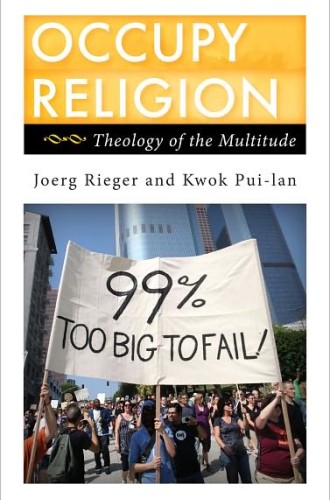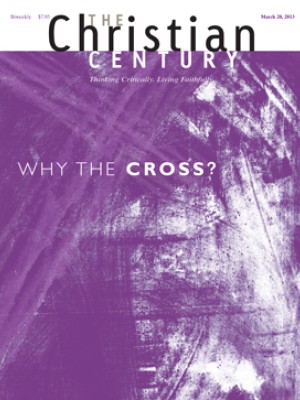Occupy Religion, by Joerg Rieger and Kwok Pui-lan
It is easy to conclude that the Occupy movement was a flash in the pan, enacted by disgruntled people without a plan or staying power, a passing whim to be forgotten. This book insists otherwise. Its authors are peculiarly equipped to make the argument. Joerg Rieger, professor of theology at Southern Methodist University, has produced a series of important studies on the role of empire in the imagination and interpretation of the Western theological tradition. Kwok Pui-lan, professor of theology and spirituality at Episcopal Divinity School, is at the forefront of a postcolonial hermeneutics that both exposes the hegemony of empire and thinks outside that hegemony for alternative possibilities. These authors are of immense importance and are not as well known as they deserve to be.
Two political theorists, Michael Hardt and Antonio Negri, have produced a series of very serious books on the current political environment on a global scale. In 2000 they published Empire, a study of the hegemony of imperial ideology. As a counterpoint, in 2005 they published Multitude: War and Democracy in the Age of Empire. These two massive studies together offer a map of social power and social possibility. It is easy to transpose the juxtaposition of the empire and the multitude onto the 1 percent and the 99 percent. Hardt and Negri present people’s action as a counterforce to empire for the sake of democracy.
Read our latest issue or browse back issues.
I linger over Hardt and Negri because Rieger and Kwok have taken up their argument, as is indicated in their book’s subtitle, Theology of the Multitude. They use the notion of multitude to refer to the Occupy movement as a particular instance of a political force outside of and over against the 1 percent of empire. And they take the Occupy movement and its 99 percent as both an embodiment of and a metaphor for the political possibility of a democratic enterprise.
Rieger and Kwok situate the Occupy movement in a global context and subject the movement and its resisters to acute theological commentary. Their theological appeal is rooted in two terms in the Greek New Testament: ochlos (“mass of people”) and laos (“common people”). One can observe empire and multitude in Luke’s articulation of a map of contested social power:
Every day [Jesus] was teaching in the temple. The chief priests, the scribes, and the leaders of the people (laos) kept looking for a way to kill him; but they did not find anything they could do, for all the people (laos) were spellbound by what they heard. (Luke 19:47–48)
Two accent points in the argument of the book merit sustained attention. First, these authors are clear that the empire-multitude juxtaposition is evidence of a class struggle that reflects an acute social, political and economic dichotomy. They characterize the empire as the “transnational capitalist class” that manages the military, controls natural resources and moves money around with ease and agility. The ideology of U.S. exceptionalism serves these powerful elites who stay focused on the control of oil production and protection. The counterpoint is the working class that supplies the cannon fodder and cheap labor that sustains the wealth and ease of the elites. The 1 percent specializes in uniformity of economic theory, uniformity of patriotic mantras and uniformity of religious orthodoxy.
The point about class is important on two counts. First, in “polite society” (meaning the society of the 1 percent) it is impolite and impolitic to introduce the category of class because the 1 percent insists on an ersatz social solidarity that keeps class hidden. But these authors assert: “Class warfare has been waged for a long time, mostly from the top down, against both workers and the middle class.”
Also, class awareness that identifies socioeconomic reality would permit and require a very different reading of scripture, which teems, in both testaments, with class reality and class awareness. Rieger and Kwok invite such an alternative reading of scripture. Class can be a powerful descriptor without any inordinate polemic attached to it. The familiar democratic palaver about everyone being in the same boat is an obfuscation. Rieger and Kwok identify some of the major players, intellectuals and activists who may empower the 99 percent to undertake a sustained action in the service of democracy.
The second major accent point is the book’s theological focus. The authors insist that “theology is not a luxury,” and they demonstrate in a compelling way that the contest for social power both reflects theological assumptions and generates and reinforces those assumptions. The transnational capitalist class, with its top-down absolutism, wants to present the status quo as the “only reality, . . . with another world viewed as impossible.” This realized eschatology at its worst depends on an absolutist God who will be the only decider of everything and who then becomes a model for absolutist human deciders.
Conversely, the multitude imagines and attests to God as an agent who is allied with a subversive agency, which may create space and alternative social possibility in the face of hegemony. In a riff that would please Richard Dawkins for a moment until he understood it, these authors assert:
Atheism has a point. . . . The deepest problem of our common images of God, supported by conservatives and liberals alike, is that images of the divine as omnipotent, impassible, and immutable tend to mirror the dominant powers that be, from ancient emperors to modern CEOs. No wonder people talk about God also as “the guy in the sky” or the “man upstairs.” . . . This connection of God and the dominant powers is no mere coincidence, it seems to us. . . . Christians have more in common with certain forms of atheism than with certain forms of theism. . . . The dominant theism of the Roman Empire was closely linked to classical theistic images of God as omnipotent, immutable, and impassible.
They offer this alternative:
Rethinking God from the bottom up, from the incarnation of God in a carpenter day laborer at home in a provincial part of the country, is at the very heart of Christianity and guides our efforts to reimagine the divine. . . . Both humanity and divinity can . . . move from the bottom up.
The book finishes with a scenario of what the church of the multitude might look like, a church devoted to reciprocity with a God who relates to the vulnerable in vulnerable ways.
This argument, voiced with passion, is at the edge of an intense summons to fresh thinking and fresh action. None of this is strikingly new; Rieger and Kwok draw on earlier expositions of the defining reality of a theology that is linked to worldly power. The volume merits attention, however, because the authors voice these matters with compelling freshness and draw them close to the facts on the ground. The book calls the transnational capitalist class—which occupies all of the symbol-generating venues in society—to wake from its dogmatic slumber. Its accent on theology is a reminder of the peculiar work that has been entrusted to the synagogue and the church that is variously presented as narrative, oracle or song, centered on exodus and crucifixion.
Rieger and Kwok entertain the thought that the Occupy movement, a modest global awakening, is a chance that a church that is too much formed by the transnational capitalist class will notice its natural constituency elsewhere. They conclude with the recognition that the theologies of the empire are “finished theologies.” The work of the multitude, however, is an unfinished theology that thrives among those who rally around Moses and Jesus.






